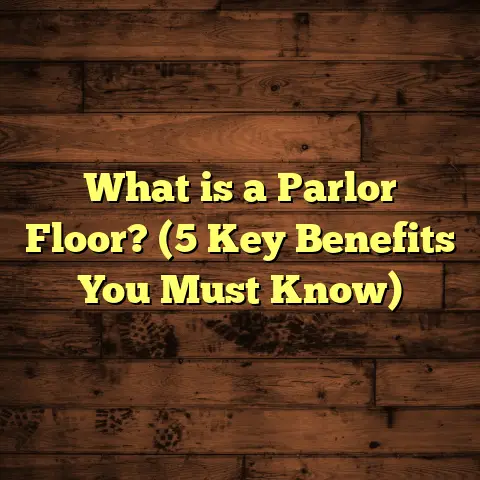What is a Safe Way to Seal a Hardwood Floor? (5 Expert Tips)
I remember the first time I decided to seal my hardwood floors. It was a Saturday morning, and I had just finished a long week of work. Standing in the center of my living room, I admired the rich colors of the wood and how the light danced on its surface. Yet, there was something nagging at me. I knew my floors needed protection, and I was determined to do it right.
Sealing hardwood floors is crucial for maintaining their beauty and durability. But how do you go about it safely? Over the years, I’ve gathered some tips that can help anyone looking to seal their hardwood floors effectively. Here are five expert tips that I’ve found invaluable.
1. Choose the Right Sealant
When sealing hardwood floors, the sealant you choose can make all the difference. You have options like polyurethane, oil-based sealers, and water-based sealers. Each type has its own set of characteristics that cater to different needs.
Types of Sealants
Polyurethane is a popular choice due to its durability and resistance to scratches. It comes in both oil-based and water-based forms:
- Oil-Based Polyurethane: This type provides a rich, warm finish and is known for its durability. However, it takes longer to dry (up to 24 hours) and has a stronger odor. It’s ideal for areas with heavy foot traffic but requires good ventilation during application.
- Water-Based Polyurethane: This is my personal favorite for indoor use because it dries quickly (usually within 2-4 hours) and has minimal fumes. It maintains the natural look of the wood without yellowing over time. It’s perfect for homes with children or pets since it poses fewer health risks during application.
In my last project, I opted for water-based polyurethane because I was sealing floors in a home with young children. I wanted something that would dry fast and not emit strong odors. It took only a few hours to apply two coats, and I could see the difference immediately.
Other Sealants
Besides polyurethane, there are other options:
- Acrylic Sealers: They offer quick-drying properties and are easy to apply. However, they may not provide the same level of protection against scratches and wear as polyurethane.
- Penetrating Oils: These oils soak into the wood and provide a natural look, enhancing the grain while protecting from moisture. However, they usually require more frequent reapplication.
- Varnishes: Similar to polyurethane but often contain higher levels of VOCs. They provide a hard finish but may not be suitable for indoor use without proper ventilation.
Tip
Always check the manufacturer’s specifications for compatibility with your existing finish, especially if you’re recoating. Trying to apply a new layer over an incompatible product can lead to peeling or bubbling.
2. Prepare the Surface Properly
Proper preparation is key to achieving a smooth and durable finish. This step can’t be rushed.
Cleaning
Start by cleaning the floor thoroughly to remove any dirt, dust, or debris. A microfiber mop can be your best friend here. For deeper cleaning, you might consider using a hardwood floor cleaner that won’t leave residue.
Sanding
If your floor has an old finish that’s wearing away or if you’re changing the stain color, sanding may be necessary. I remember taking on a project where the previous owner had used a dark stain that didn’t match my vision for the space. After sanding down to bare wood and vacuuming up the dust, it was like starting fresh!
Here’s a step-by-step breakdown of the sanding process:
- Choose Your Sandpaper: Start with a coarse grit (around 36-60) to remove the old finish and work your way up to finer grits (120-220) for smoothing.
- Use a Drum Sander: For large areas, a drum sander will save you time. Be sure to rent one from your local hardware store if you don’t own one.
- Edge Sanding: Don’t forget about edges! Use an edge sander or hand sand those hard-to-reach spots.
- Clean Up: Vacuum thoroughly afterward to ensure no dust particles will interfere with the sealant.
Data Point
According to the National Wood Flooring Association, proper preparation can increase the lifespan of your finish by 30% or more.
3. Apply Even Coats
When it comes to applying the sealant, consistency is key.
Application Techniques
Use a high-quality applicator pad or brush for even coverage across the surface. I like to start at one corner of the room and work my way out, ensuring I don’t trap myself in a corner!
Here’s my go-to method for applying sealant:
- Stir Well: Make sure to stir your sealant thoroughly before application to mix any settled components.
- Use Long Strokes: Apply with long strokes in the direction of the wood grain to avoid lap marks.
- Work in Sections: Divide your floor into manageable sections to keep track of where you’ve applied sealant.
- Check for Bubbles: If you notice bubbles forming during application, use a brush to gently pop them as you go.
During my last project, I made the mistake of applying too much product on my first coat—resulting in drips in some areas. Fortunately, I was able to sand them down later but regretted not sticking to thin coats from the start.
Tip
Allow each coat to dry completely before applying the next one. Check the manufacturer’s instructions for specific drying times—this is crucial for achieving a professional finish.
4. Ventilation Is Key
Sealing hardwood floors can release volatile organic compounds (VOCs), which can be harmful if inhaled in large quantities. Therefore, proper ventilation is critical during application.
Creating Airflow
I always open windows and set up fans to create airflow when I’m sealing floors. In one project, I had a friend help me by standing at the opposite end of the room with a fan while I applied the sealant. It made a noticeable difference in keeping the air fresh and reducing odors.
Here are some additional ventilation tips:
- Use Exhaust Fans: If available, turn on exhaust fans in nearby rooms or bathrooms to enhance airflow.
- Seal Off Other Areas: Close doors to other rooms to prevent fumes from spreading throughout your home.
- Wear a Mask: A good respirator mask can protect you from inhaling fumes while working.
Statistic
The EPA states that indoor air quality can be significantly improved by maintaining good ventilation during projects involving chemicals. In fact, poor indoor air quality can lead to long-term health issues.
5. Maintain Your Sealed Floors
Once your hardwood floors are sealed, maintenance becomes essential for prolonging their life.
Regular Cleaning
Regular cleaning with a soft broom or microfiber mop will help maintain that beautiful finish. I like to use a pH-neutral cleaner specifically designed for hardwood floors. It’s gentle yet effective, ensuring that my sealant lasts longer without dulling over time.
Here’s how I maintain my sealed floors:
- Daily Maintenance: Sweep or vacuum regularly to remove dirt and debris that can scratch your floors.
- Spot Cleaning: Clean up spills immediately using a damp cloth—never soak your hardwood!
- Monthly Deep Cleaning: Use a hardwood-specific cleaner once a month for deeper cleaning without damage.
Reapplication Schedule
Did you know that reapplying sealant every 3-5 years can help protect your investment? A simple inspection once a year can help you catch any issues early on before they turn into larger problems.
Signs That Your Floor Needs Re-sealing:
- Faded Appearance: If your floor starts looking dull compared to its original luster.
- Water Absorption: If water beads up instead of being repelled, it might be time for another coat.
- Scratches or Scuffs: Increased visibility of wear may indicate reduced protection.
Personal Anecdotes
Throughout my experiences with sealing hardwood floors, I’ve encountered many lessons learned through trial and error. On one occasion, I worked on a beautiful oak floor that had seen better days—it was scratched and faded but had so much character! After sanding it down and applying multiple coats of water-based polyurethane, it transformed into something truly stunning.
I remember my neighbor’s reaction when he first stepped inside after I finished; his eyes widened as he exclaimed how beautiful it looked! Moments like those remind me why I love what I do—seeing the transformation unfold is incredibly rewarding.
In another instance, while sealing my kitchen floors, I underestimated how much time it would take for everything to dry properly between coats. With two kids running around, I had to get creative! We worked around each other by setting up play areas in rooms where we had already sealed—those moments taught me flexibility is key in home improvement projects!
Expert Insights
Over many years in this field, I’ve also learned valuable insights from fellow contractors and experts in flooring:
- Test Areas First: Always test your chosen sealant on a small area first before applying it across larger sections—this ensures you’re happy with both the appearance and durability.
- Consider Environmental Factors: Seasonal changes can affect drying times; humidity levels can slow down drying significantly, so always factor this into your plan.
- Stay Updated on Trends: New products come out regularly—staying informed about advances in flooring technology can give you an edge when choosing materials or methods.
Conclusion
Sealing hardwood floors doesn’t have to be overwhelming. With the right materials, preparation, and care, you can achieve stunning results that will keep your floors looking beautiful for years to come.
I hope these tips help you on your journey to sealing your hardwood floors safely and effectively! What experiences do you have with sealing? Have you ever tried different sealants? I’d love to hear about your projects!





